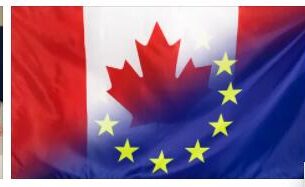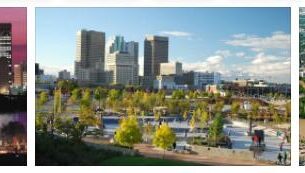With the colonization of the country, European architectural forms were imported into Canada, but some local characteristics soon developed within this import culture, such as country houses and churches with steeply sloping roofs. In the English period (1763-1867) both the Regency style and the North American Georgian style were established, while in the second half of the nineteenth century the imitation of ancient styles spread, particularly of the Gothic which determined the appearance still typical of many Canadian cities.. In painting, too, external influences were decisive. At the end of the century the influence of the Barbizon School was noticeable, especially in the works of H. Sandham (1842-1910) and O. Watson (1855-1936). But the greatest artist of the time was undoubtedly O. Leduc (1864-1955), whose independence and originality had a great impact on subsequent generations. Young artists, including J.-P. Riopelle (1923-2002), took the example of P.-E. Borduas (1905-1960), the godfather of automatism, the trend that taught Montreal from 1946 to 1960. After 1940 Toronto and Vancouver also became important centers of activity, welcoming abstract artists, such as BC Binning, J. Shadbolt, JWG MacDonald (who directed in Toronto, in 1954, the newborn Group of Eleven), H. Town and W. Ronald. Alongside the abstract and surrealist modes of expression, there was no lack of pictorial manifestations in Canada related to figurativism and landscape, as well as interests cultivated in the context of the themes dear to Fluxus, represented by R. Page. Among the sculptors, L.-Ph. Hébert (1850-1917), who was responsible for the decoration of the Parliament building in Québec and the statue of Maisonneuve in Montreal, but it must be said that sculpture, in the twentieth century, never reached the visibility and interest aroused by painting. The second half of the twentieth century saw the early recourse, by many artists, to the so – called mixed-media, according to a perspective that often preceded the notion of “contemporary” in art. Michael Snow (b.1929), Betty Goodwin (1923-2008), Ivan Eyre (b.1935) are the names of some of these pioneers who helped to mark the Canadian path towards contemporary art, from video art to performance. Of note is the constant growth in the number and importance of institutions for the promotion of Canadian art, from the Museum of Contemporary Canadian Art (Toronto, 1999) to the Canadian Art Database project. Great protection and support were registered in the last decades of the twentieth century for Inuit and native art. Paintings, prints and workmanship in bone or stone combine modern skill with the centuries-old tradition of indigenous cultures. In architecture, the forms of the European tradition during the twentieth century gradually gave way to structures and movements that often found their center of gravity in the Center canadien d’architecture in Montréal, a national reference institution. Among the most important figures are Arthur Erickson (1924-2009), R. Keenenberg (b.1941), the avant-garde group of Patkau Architects. The works of female artists C. Whiten (b.1945), G. Cadieux (b.1955), S. Keely (b.1955) focus on themes such as physical and sexual reality, represented through paintings but also videos and performances. We also remember the installations by J. Sterback (b. 1955) which focus attention on female alienation, and the works of M. Lewis (b 1948); J. Cardiff (b.1957) and G. Bures Miller (b.1960).
Yukon Territory
According to aristmarketing, Yukon [ ju ː k ɔ n ter ɪ təri], is the management area in Canada, 474,713 km 2, (2017) 38,500 residents (of which almost 26% Indians); The capital is Whitehorse.
The territory comprises the extreme northwest of Canada between the Arctic Ocean, Alaska, the Northwest Territories and the province of British Columbia. The largest part is taken up by the Yukon Plateau (about 1,000 m above sea level). The highest mountain in Canada, the heavily glaciated Mount Logan (5,959 m above sea level), lies in the Saint Elias Mountains with the Kluane National Park, which are part of the mountain range of the Yukon Plateau. A coastal plain is formed on the Arctic Ocean (Beaufort Sea). There is a continental climate with very cold winters (lowest measured air temperature so far: -62.8 ° C in Snag, one of the cold poles on earth) and short summers (Whitehorse: mean July temperature 14.2 ° C, absolute maximum 32.8 ° C). Treeless tundra vegetation predominates; about 17% of the area is forested, especially lower areas.
Mineral resources are zinc and lead ore, silver and gold, and natural gas. In 1896 there was a gold rush in the Klondike area with Dawson as the starting point. Fishing for fur is traditional (including marten, lynx, black bear, grizzly). The south is accessed by the Alaska Highway, the north by the Dempster Highway. From 1900 to 1982 there was a rail link between the port of Skagway (Alaska) and Whitehorse (176 km); since 1992 it has been in operation again in the summer months. The flight connections are important. Tourism also plays a role; many tourists are passing through on their way to Alaska.
History: The area of today’s Yukon Territory was explored from 1842 by fur traders of the Hudson’s Bay Company; In 1869 it came into Canadian possession. It was part of the Northwest Territories; since 1898 it has been organized as a separate territory. In 1905 the Yukon Territory received an elected five-member legislative council.



